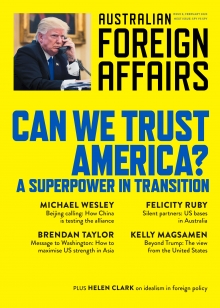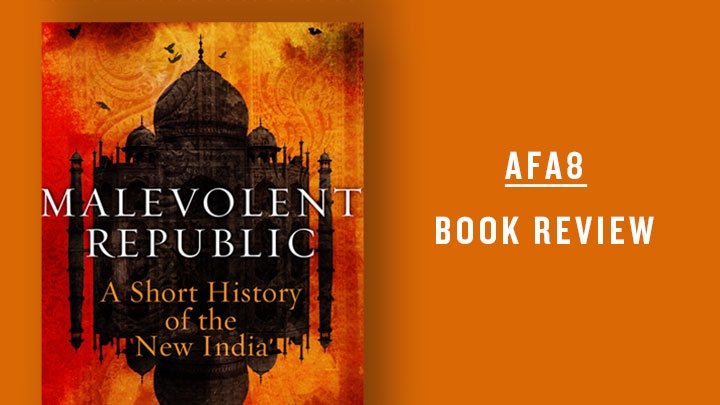
This review is featured in Australian Foreign Affairs 8: Can We Trust America?.
To read the full issue, log in, subscribe or buy the issue.
Twelve years ago, I was sitting in a Shanghai auditorium, waiting to take the stage for a discussion of matters literary. The speaker preceding me was the Indian novelist – and, by then, polemicist – Arundhati Roy.
Roy has a beautiful voice, the kind that makes you want to close your eyes and just listen to her cadences. So I did. But her speech was disturbing. She spoke of political horrors so extreme you would have thought her topic was Nazi Germany. Yet she was speaking about the world’s largest democracy, India.
Recently, reading Kapil Satish Komireddi’s debut book-length polemic Malevolent Republic: A Short History of the New India, I was reminded of that moment in Shanghai when a renowned Indian author seemed to me to lose perspective. But then, I am also reminded of Nobel Laureate Amartya Sen’s celebration of the “argumentative Indian”, and his vision of India as an ongoing religious, political and economic arm-wrestle.
Komireddi’s strident book appears in the wake of last year’s historic election victory for Prime Minister Narendra Modi and his Bharatiya Janata Party (BJP). The Congress Party – which secured India’s independence in 1947 under the leadership of Jawaharlal Nehru and the cajoling of Mahatma Gandhi – was shattered by its worst ever electoral performance, gaining less than 20 per cent of the national vote. For Komireddi, the result was both regrettable and inevitable, a logical outcome of decades of the Congress Party’s corruption, dynastic rule and betrayal of India’s secular foundations for short-term political gain. However, it is the Hindu nationalist BJP, and Modi in particular, who cop the brunt of the author’s ire.
Komireddi’s central thesis is that India is undergoing a creeping, bottom-up political and cultural revolution that could conceivably bring about a Hindu nation-state, a mirror image of Pakistan, in which 200 million Indian Muslims end up as second-class citizens. Unfortunately, recent events – most notably, the introduction of a discriminatory citizenship law that sparked clashes between demonstrators and police – lend credibility to what might otherwise have been dismissed as a fevered, far-left fantasy.
In his first term, the energetic Mr Modi reached out to the world, including India’s near neighbours, blunting fears he would pursue a sectarian agenda. But in August 2019, the Modi government took the extraordinary step of revoking the limited autonomy granted under Article 370 of the Indian constitution to the state of Jammu and Kashmir, and cut lines of communication within the Muslim-majority Kashmir Valley. Hindu nationalists cheered. Then, in November, the Supreme Court ruled that the long-disputed religious site at Ayodhya, in India’s most populous state of Uttar Pradesh, would be handed to a trust that will construct a Hindu temple on the ruins of a Muslim shrine destroyed by a Hindu mob in 1992. The hoodlums guilty of that crime – which I was there to witness – have never been brought to justice.
In days gone by, such a ruling would have triggered an immediate backlash from the Congress, but the party is now deeply divided, as is the broader polity after decades of caste-based politics. Komireddi writes, “India’s tragedy is that just when it is faced with an existential crisis, there exists no pan-Indian alternative to the BJP … The values of Hindu nationalism have become the default setting of Indian politics.” He portrays Indian corporates as fawning lackeys of Modi and claims that respected institutions, including the Election Commission of India, the Reserve Bank of India, the judiciary and even the military, have been cowed into silence, unwilling or unable to defend the country’s secular constitution. And he quotes social theorist Ashis Nandy, who once interviewed Modi, describing the current leader of the world’s largest democracy as “a fascist and a prospective killer, perhaps even a future mass murderer”.
At times, Komireddi’s hyperbole gets the better of his analysis, but he writes with insight, passion and an arresting vocabulary of rarely used words, spoilt by almost as many typos. For this reader, Malevolent Republic is most persuasive when it details Modi’s numerous policy missteps: the bungled and ill-considered abolition of small-denomination rupee banknotes; the short-lived rapprochement with India’s neighbours that quickly turned into a series of nasty spats, including a tense military standoff with China in Sikkim in 2017; the bullying of landlocked Nepal that served only to strengthen pro-China sentiment there; and a confused and confusing carbon reduction strategy.
According to news magazine India Today, unemployment is at a forty-year high of 6 per cent, while the Press Trust of India reports that direct foreign investment actually declined in 2019 to a six-year low. The economy is still growing at 7 per cent annually, but observers warn that the potential demographic dividend of a young population may evaporate unless policymakers respond better to local conditions in the country’s twenty-nine states. If they don’t, young voters inspired by Modi could quickly become disillusioned with him.
There are, then, two Narendra Modis in Malevolent Republic. One is an incompetent Dr Jekyll, ruling via a series of ill-considered thought bubbles; the other an evil Mr Hyde spurred by religious nationalism.
Both are plausible, but can they simultaneously be true? And if not, which is the real Modi? Unfortunately, it is a question the author neither asks nor answers.
Indians frustrated with corruption and inefficiency have long dreamt of a messiah who will drag the country forward. Partition-era squabbles over Kashmir and Ayodhya are indeed costly and distracting. Yet for Komireddi, Modi’s sectarianism – his blind eye to the violence of Hindu mobs – will make India less just, more divided along ethnic and religious lines, and dangerously at odds with its neighbours.
In 2014, Sanjaya Baru, a journalist and former media adviser to outgoing prime minister Dr Manmohan Singh, commented that Modi’s rise to power heralded the birth of a second Indian republic. Komireddi cites Baru’s observation that “our nation’s first phase of being a republic lasted from 1950 to 2014, the second phase has begun”. Interpreting this comment, Komireddi adds, “He [Baru] meant that the India founded in 1947 by Congress was dead.”
Modi’s ascendancy may not continue. Voters will punish any sign of hubris or incompetence. But things that were once unthinkable in India are now happening, lending an air of prophecy to Komireddi’s grim observations that “we inhabit the most degraded moment in the history of the Indian Republic” and “if a temple rises on the site of the Babri mosque, it will be as a tombstone for the secular state”.
Modi’s second term is less than a year old, but it is already looking very different from his first. The second Indian republic beckons.
Christopher Kremmer







